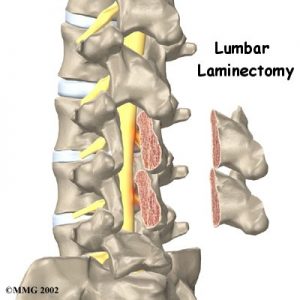Lumbar Laminectomy Surgery
For Leg Pain Relief
• Also, know as Lumbar Decompressive Laminectomy
A lumbar laminectomy surgical procedure removes pressure on the nerves in the low back which is caused by thickened ligament and arthritis. The lamina, the bone forming the roof of the spinal canal, is removed in order to take the pressure off of the nerves in the low back; hence, it is also referred to as decompressive or decompression laminectomy. It is performed when more conservative treatments do not work.
Lumbar Spinal Fusion may be done at the same time when sufficient bone is removed to cause the spine to become unstable. It may also be added if there is severe low back pain or mechanical instability.
The most commonly affected levels in the lumbar spine are L3, L4, and L5. The procedure is done through a vertical incision in the low back with a microscope to provide excellent visualization of the nerves.

This surgery is generally performed to relieve leg pain often associated with walking and standing. When the patient walks or stands, the ligament which is positioned in the spine behind the nerves can buckle in and press upon the nerves.
Before the operation begins, the anesthesiologist will put the patient to sleep. The patient will then be turned on to their stomach in the operating room. This is done in an extremely careful manner to protect all pressure points. After the appropriate antibiotics are given, an x-ray may be used to guide the placement of the incision.
he incision is performed in the midline. When the lamina is exposed, the surgeon then removes this portion while visualizing it under the microscope. Micro-instruments are used to make sure that the nerves are completely free. After this is done, the wound is irrigated with an antibiotic solution and closed.
Patients are generally discharged home the day of or the day following surgery. The leg pain is typically significantly improved although the patient may experience numbness in the leg, twinges of leg pain, pain around the incision and, at times, spasm of the back muscles. Medications will be given for this. This should improve within one to two weeks after surgery.
Patients should keep their back incisions dry until they are seen in the office generally seven to ten days after surgery. They should try to avoid any bending, lifting or twisting for four to six weeks after surgery. Depending upon the type of work they do for a living and how strenuous their job requirements are, they may return to work within two to four weeks with some temporary restrictions.
Risks of the surgery are generally low. Potential risks include bleeding, infection, nerve injury, spinal fluid leak and recurrence of another disc herniation at the same level.